| AKA: Greek Hydra | |
|---|---|
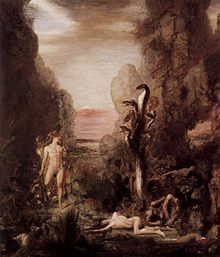 The 19th-century French artist Gustave Moreau was influenced by the Beast of Revelation in his depiction of the Hydra. | |
| Mythology | Greek mythology |
| Grouping | Legendary creature |
| Sub-grouping | Serpent-like water spirit |
| Parents | Typhon & Echidna |
| Country | Greece |
In Greek mythology, the Lernaean Hydra (Greek: Λερναία Ύδρα) was an ancient serpent-like chthonic water beast, with reptilian traits (as its name evinces), that possessed many heads — the poets mention more heads than the vase-painters could paint, and for each head cut off it grew two more — and poisonous breath and blood so virulent even its tracks were deadly.[1] The Hydra of Lerna was killed by Hercules as the second of his Twelve Labours. Its lair was the lake of Lerna in the Argolid, though archaeology has borne out the myth that the sacred site was older even than the Mycenaean city of Argos since Lerna was the site of the myth of the Danaids. Beneath the waters was an entrance to the Underworld, and the Hydra was its guardian.[2]
The Hydra was the offspring of Typhon and Echidna (Theogony, 313), both of whom were noisome offspring of the earth goddess Gaia.[3]
The Second Labour of Hercules
After slaying the Nemean lion, Eurystheus sent Hercules to slay the Hydra, which Hera had raised just to slay Hercules. Upon reaching the swamp near Lake Lerna, where the Hydra dwelt, Hercules covered his mouth and nose with a cloth to protect himself from the poisonous fumes. He fired flaming arrows into the Hydra's lair, the spring of Amymone, a deep cave that it only came out of to terrorize neighboring villages.[4] He then confronted the Hydra, wielding a harvesting sickle (according to some early vase-paintings), a sword or his famed club. Ruck and Staples (1994: 170) have pointed out that the chthonic creature's reaction was botanical: upon cutting off each of its heads he found that two grew back, an expression of the hopelessness of such a struggle for any but the hero. The weakness of the Hydra was that it was invulnerable only if it retained at least one head.
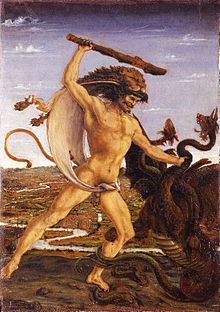
The details of the struggle are explicit in the Bibliotheca (2.5.2): realizing that he could not defeat the Hydra in this way, Hercules called on his nephew Iolaus for help. His nephew then came upon the idea (possibly inspired by Athena) of using a firebrand to scorch the neck stumps after each decapitation. Hercules cut off each head and Iolaus cauterized the open stumps. Seeing that Hercules was winning the struggle, Hera sent a large crab to distract him. He crushed it under his mighty foot. The Hydra's one immortal head was cut off with a golden sword given to him by Athena. Hercules placed the head – still alive and writhing – under a great rock on the sacred way between Lerna and Elaius (Kerenyi 1959:144), and dipped his arrows in the Hydra's poisonous blood, and so his second task was complete. The alternative version of this myth is that after cutting off one head he then dipped his sword in it and used its venom to burn each head so it couldn't grow back. Hera, upset that Hercules slew the beast she raised to kill him, placed it in the dark blue vault of the sky as the Constellation Hydra. She then turned the crab into the Constellation Cancer.
Hercules would later use arrows dipped in the Hydra's poisonous blood to kill other foes during his remaining Labours, such as Stymphalian Birds and the giant Geryon. He later used one to kill the centaur Nessus; and Nessus's tainted blood was applied to the Tunic of Nessus, by which the centaur had his posthumous revenge. Both Strabo and Pausanias report that the stench of the river Anigrus in Elis, making all the fish of the river inedible, was reputed to be due to the Hydra's poison, washed from the arrows Hercules used on the centaur.[5]
When Eurystheus, the agent of ancient Hera who was assigning The Twelve Labors to Hercules, found out that it was Hercules' nephew Iolaus who had handed him the firebrand, he declared that the labor had not been completed alone and as a result did not count towards the 10 Labours set for him. The mythic element is an equivocating attempt to resolve the submerged conflict between an ancient ten Labours and a more recent twelve.
Hercules and the hydra in art
-
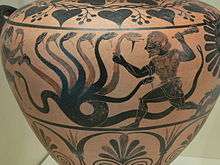
Caeretan black-figure hydria (ca.346 BC)
-

Engraving (1) by Hans Sebald Beham
-

Gustave Moreau (1861)
-
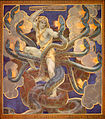
John Singer Sargent (1921)
Constellation
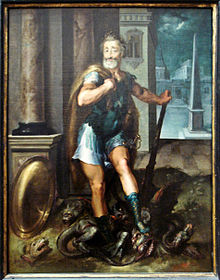
Mythographers relate that the Lernaean Hydra and the crab were put into the sky after Hercules slew them. In an alternative version, Hera's crab was at the site to bite his feet and bother him, hoping to cause his death. Hera set it in the Zodiac to follow the Lion (Eratosthenes, Catasterismi). When the sun is in the sign of Cancer, the crab, the constellation Hydra has its head nearby.
In popular culture
- Hydra (film), a 2009 low-budget monster movie
- Jason and the Argonauts (film), a 1963 film featuring a battle between Jason and a Hydra.
- " Dragon's Dogma" (video game), In the beginning of the game the player encounters a hydra conjured by a sorcerer. Later after the player has beaten the game they can take an optional quest to battle a four-headed black hydra.
- The Lernaean Hydra shows up as an optional boss in the "legendary" difficulty mode of the computer game Titan Quest.
- The Lernaean Hydra is a unique monster in the computer game Dungeon Crawl Stone Soup.
- Lernaea is the name of a member of the Heroic Tribe in 2007's Heroic Age (anime), who has the ability to transform into a multi-headed serpent.
- "Die Zähmung der Hydra", a 2012 music release by the german hip-hop Project Shaban & Käptn Peng.
- Hydra (album), a 2013 music release by the nu-metal band Otep.
- The Hydra also showed up in the film, Percy Jackson and the Olympian: The Lightning Thief
Notes
- ^ "This monster was so poisonous that she killed men with her breath, and if anyone passed by when she was sleeping, he breathed her tracks and died in the greatest torment." (Hyginus, 30).
- ^ Kerenyi (1959), 143.
- ^ For other chthonic monsters said in various sources to be ancient offspring of Hera, the Nemean Lion, the Stymphalian birds, the Chimaera, and Cerberus.
- ^ Kerenyi, The Heroes of the Greeks(angelo) 1959:144.
- ^ Strabo, viii.3.19, Pausanias, v.5.9; Grimal 1987:219.
Sources
- Harrison, Jane Ellen (1903). Prolegomena to the Study of Greek Religion.
- Graves, Robert (1955). The Greek Myths.
- Kerenyi, Carl (1959). The Heroes of the Greeks.
- Burkert, Walter (1985). Greek Religion. Harvard University Press.
- Ruck, Carl and Staples, Danny (1994). The World of Classical Myth.
- Grimal, Pierre (1986). The Dictionary of Classical Mythology. E.P. Dutton & Co., Inc.
- Piccardi, Luigi (2005). The head of the Hydra of Lerna (Greece). Archaeopress, British Archaeological Reports, International Series N° 1337/2005, 179-186.
External links
| |||||

_02.jpg)

